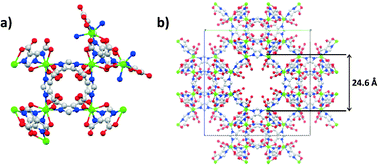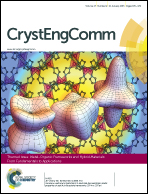Transition metal inclusion in RhoZMOF materials†
Abstract
Porous RhoZMOF is a negatively charged zeolite-like MOF material susceptible to post-synthesis modification by an ion-exchange process replacing as-synthesized organic cations with transition metals. This material exhibiting open transition metal sites is a very attractive candidate for industrial applications related to clean energy technologies, like electrochemistry and gas storage. In the present work, partial or total Co2+, Ni2+ and Cu2+ inclusions have been successfully carried out in the RhoZMOF structure by ion-exchange treatment. Particularly, complete exchange of HDMA+ with Co2+ could be reached at room temperature after 12 h of contact time. For Cu2+ exchange, a rapid transformation of the RhoZMOF structure into a new Cu-rich, crystalline and practically non-porous phase was observed at room temperature; its appearance can be avoided and the desired structure can be preserved when ion-exchange treatment is carried out at −20 °C for 6 h, reaching a partial ion-exchange degree of 30%. Moreover, for Ni2+ ion-exchange treatment at 25 and 0 °C, a covering of an amorphous Ni-rich organometallic phase over the crystals was detected by SEM analysis; its appearance can be prevented by reducing the amount of HDMA+ in the media by developing the ion-exchange process in two steps: exchanging HDMA+ with Na+ and Na+ with Ni2+. The results provide a post-synthesis modification route for obtaining porous MOF materials containing open transition metal sites accessible for redox catalysis and selective gas adsorption.

- This article is part of the themed collection: Metal-Organic Frameworks and Hybrid Materials

 Please wait while we load your content...
Please wait while we load your content...